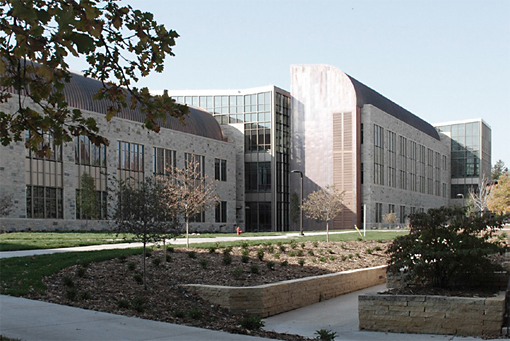| 제목 | [DAIKIN] HIGHER EDUCATION - St Olaf Science Bldg | 작성일 | 16-06-16 13:39 |
| 글쓴이 | 최고관리자 | 조회수 | 5,194 |
본문
St. Olaf College Regents Hall for Natural Sciences, Northfield, Minnesota
CASE STUDY
Higher Education
Name
Regents Hall for Natural Sciences
Location
Northfield, MN USA
Building Size
190,400 ft2 facility
Issue
Sustainable design and reduce energy costs by 50 percent compared to the Minnesota Energy Code model
Solution
Daikin extended-size Vision® air handling system
Designed for LEED® Platinum certification, Regents Hall at St. Olaf College combines sustainable design, interdisciplinary science education
Already recognized as a leader among baccalaureate colleges for its commitment to science education, St. Olaf College, Northfield, Minnesota, anticipates being one of the few institutions worldwide to receive a LEED® Platinum rating for a science facility. The college's new Regents Hall for Natural Sciences, a teaching and research center which opened in September 2008, will provide a learning experience for students, faculty, staff and visitors well into the 21st century. The 190,400-square-foot building combines interdisciplinary education with sustainable design and is expected to reduce energy costs by 50 percent compared to the Minnesota Energy Code model, which is now based on ASHRAE 90.1.
Science centers are not by design energy-efficient, due mostly to their high air-exchange requirements. One of Regents Hall's many sustainable features is an HVAC system designed with an innovative extended-size, 53,000 cubic-foot-per-minute (cfm) Vision® air handling system from Daikin. This unique system is designed not only for high air exchange (which contributes to high IAQ), but also for low energy consumption. In fact, it helped the college earn LEED points and meet its budget requirements.
Building systems work together in sustainable design
"We designed the building so we could support an innovative science program without imposing a huge operating cost increase on the overall college budget," said Pete Sandberg, assistant vice president for facilities, St. Olaf College. "We try to operate with as few BTUs (British Thermal Units) per square foot and as little carbon footprint as possible. Our goal is stewardship of the resources that families have committed to their children's educations."
This careful attention to sustainability has paid off already in the first year. "We added 190,400 square feet of technical space, and the base energy model for the building predicted more than 10-million KWHs would be consumed annually if designed and constructed just to meet the code level," said Sandberg. "The aggressive design changed the model to predict 4.2-million, and we actually operated the first 12 months using 2.7-million KWHs."
The anticipated LEED rating also underscores the college's commitment. The Platinum rating is the highest of the four-tiered LEED rating system, which awards points based on sustainable site, water efficiency, energy and atmosphere, indoor air quality, and materials and resources. The building was designed to meet LEED NC (new construction) 2.1, which requires that 52 credits be met in order to achieve Platinum certification. St. Olaf anticipates achieving 14 out of 14 possible credits in the Sustainable Sites category; 4 out of 5 for Water Efficiency; 16 out of 17 for Energy and Atmosphere; 9 out of 13 for Material and Resource; 12 out of 15 for Indoor air Quality; and all 5 possible Innovation credits.
The $64 million building, designed by the Rochester, Minn. office of the architectural firm Holabird & Root, based in Chicago, not only replaces a 40-year-old science building, it is a model for interdisciplinary science education. While Chemistry 101 is still taught here, lessons include how the green roof impacts a waterfall collection system to reduce the cooling load. Regents Hall is also the first major science facility in the country designed for "green chemistry" which minimizes the hazardous chemical waste from lab experiments. The labs use one half the number of fume hoods compared to the same curriculum with conventional chemistry.
In all, the building includes 26 teaching labs, seven tiered classrooms, 11 flat-floored classrooms, eight seminar-style rooms, five dedicated computer rooms, an 8,000-square-foot science library, student-faculty research space, group study spaces and informal gathering spaces. This adds up to an 850-ton cooling load for the entire building. Helping to reduce that load are innovative sustainable systems such as a green roof, abundant day lighting, highly efficient use of ventilation air and a heat recovery system to reclaim exhaust air energy.
HVAC innovation meets budget
All of these sustainable systems put special design challenges on the HVAC system due to the high airflow requirements. "The first priority was to design the building for St. Olaf's own Sustainable Design Guidelines, which we believe equate well to LEED Gold," said Sandberg. "That meant high indoor air quality, which for a science building requires some special considerations. Fume hoods in research labs are notoriously inefficient and can discharge potential contaminants. To meet both LEED and the Guidelines, which are incorporated into all contracts as a part of the Owner's Project Requirements, priorities were energy recovery, efficient air exchange and quiet operation."
The air distribution system has several energy-saving features: a heat recovery loop, a cascade air system and a low-flow VAV fume hood exhaust system. All depend on the flexibility of the extended-size Vision air handling unit. Facility officials at St. Olaf and the project design team worked closely with Schwab-Vollhaber-Lubratt, Inc., St. Paul, the Daikin rep firm, to design a system that exactly met their requirements.
The first of these features is a glycol heat recovery loop that recovers heat from the laboratory fume hood exhaust air stream. A standard water coil is located in the laboratory exhaust manifold upstream of the exhaust fans and a similar coil is strategically located in the air handling unit. Energy is transferred from the warm exhaust air to the glycol loop and transported to the air handling unit coil where it is used to preheat the outside air coming into the unit. Even during very cold outdoor conditions, the need for steam heat is greatly diminished due to the heat provided by the heat recovery coil. If necessary, a reheat coil on the VAV boxes will reheat the air when it reaches the space.
The second feature, a cascade air system, is an efficient way to provide the high air exchange rate required for the laboratories. "We can't recirculate lab air; we have to bring in outside air and large amounts of it. Once air enters a lab, it must be exhausted to the outdoors," said Brett Gorden, design engineer, MEP Associates, Rochester (formerly with Holabird & Root). "So we mix all of the outside air required for the laboratories with the return air from the offices and classrooms and supply that to both types of spaces. This essentially provides the necessary ventilation air to the offices and classrooms for free. One large mixing box manages each half of the building."
According to Gorden, these energy-saving benefits can be accomplished because of the design flexibility of the Daikin Vision air handling units. "The air handling units required a lot of custom modifications, such as isolating sections through the use of integral dampers to make all of these systems work. An additional challenge was designing an economical air handling unit capable of the large amount of airflow and high static pressure requirements. Daikin was willing to work with us on these needs."
Vision AHU designed for flexibility
Regents Hall is divided into east and west wings joined by an atrium. The extended-size Vision air handling unit serves the entire east wing. Five smaller Vision air handling units serve the west wing and a single, stacked Vision unit serves the Link, which connects Regents Hall to the newly remodeled Old Music Building. Originally, nine air handlers were specified, but the extended-size Vision unit replaced three of them, significantly reducing installed and operating costs.
The building's original HVAC plans specified custom air handlers, but Greg Pumper, project manager with HiMEC Mechanical, Rochester, Minnesota, had other ideas. "This was a design-assist project, meaning that all disciplines had input," he said. "We worked off the plan and gave our ideas for what could be done to cut costs. We used ProPress fittings on the copper pipe rather than soldering everything, and we used a different kind of stainless duct. We were able to use a low-VOC caulk on the stainless steel exhaust duct rather than weld it. The biggest cost savings came from being able to replace the three air handlers for the east side into one extended-size unit."
The extended-size Vision unit, with a coil face area of 142.5 square feet, is built on a custom-modular platform. Compared to custom units, the Daikin single unit reduces cost in part by eliminating a common wall and minimizing space requirements. The Daikin Variable Dimensioning® feature lets engineers specify cabinet sizes in increments of two inches high and four inches wide, making it easier to configure a short-and-wide unit for Regents Hall's high-air-volume requirement. Dual plenum fans in the unit also help reduce energy consumption as well as ensure quiet operation.
The modular construction simplified installation, according to Pumper. Vision units are assembled at the factory and shipped in sections. The units are built with a patented splice collar to simplify section-to-section fit and seal without additional nuts, bolts, screws, gasketing or caulking. "Our foreman said that the units were well built and easy to put together compared to some others he's done," said Pumper.
Energy-saving results
With so much attention to energy savings, Sandberg knew the operating data would be positive, but even he is surprised. "We're operating at one-third of the predicted costs," he said.
Yet thinking green is nothing new at St. Olaf. "Ten years ago, we started developing our own sustainable design guidelines and made them part of our design and construction contracts," said Sandberg. "Regents Hall is the building we would have built even if LEED didn't exist. It's that important to St. Olaf to provide the best teaching environment it can."
| 이전글 | [DAIKIN] HIGHER EDUCATION - Pima Community College 2016-06-16 | ||
| 다음글 | [DAIKIN] HIGHER EDUCATION - UofM Alumni Center 2016-06-16 | ||






